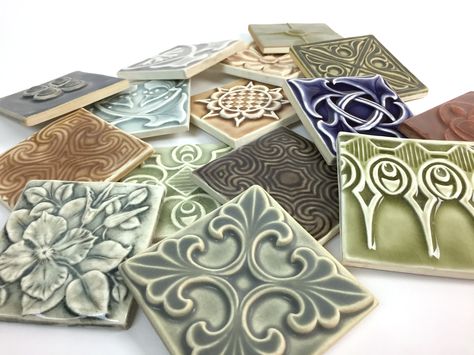Handcrafted tiles are more than just decorative materials; they embody artistry, tradition, and timeless elegance. Whether adorning kitchen backsplashes, bathroom walls, or living room floors, handcrafted tiles deliver a distinctive character that mass-produced tiles simply cannot replicate. Their uniqueness lies not only in their aesthetic appeal but also in their meticulous production process, historical roots, and diverse applications. In this article, we will explore the many reasons why handcrafted tiles are an excellent choice for enhancing interior and exterior spaces.
A. The Artistic Process Behind Handcrafted Tiles
Each handcrafted tile undergoes an intensive artistic process that reflects the skill and creativity of the artisan. Unlike machine-made tiles that are produced in bulk with uniform patterns, handcrafted tiles are carefully shaped, glazed, and painted by hand. This artisanal touch results in subtle variations in color, texture, and design, giving every tile its own personality.
The process typically involves several steps:
A. Clay preparation: Artisans select high-quality clay, often locally sourced, and knead it to achieve the right consistency.
B. Molding: The clay is shaped into tiles using wooden molds or manually pressed into desired forms.
C. Drying: The tiles are air-dried to remove moisture before firing.
D. Firing: The tiles are baked in kilns at high temperatures to harden the clay.
E. Glazing and painting: After the initial firing, tiles are glazed and hand-painted with intricate designs.
F. Final firing: The tiles undergo a second firing to set the glaze and colors permanently.
This labor-intensive process makes each handcrafted tile a unique piece of functional art. The variations in hue and texture create depth and visual interest when installed, transforming plain surfaces into vibrant mosaics.
B. Historical Significance and Cultural Heritage
Handcrafted tiles have a rich history that spans centuries and continents. From the colorful azulejos of Portugal to the intricate zellige of Morocco, tiles have played a significant role in architectural traditions worldwide. Their designs often reflect cultural motifs, religious symbols, and regional aesthetics, making them deeply meaningful beyond their decorative function.
In ancient times, tiles were used to adorn palaces, mosques, and temples, symbolizing wealth, status, and artistry. Today, incorporating handcrafted tiles into modern spaces connects homeowners with this heritage, blending old-world charm with contemporary design. The timeless appeal of handcrafted tiles ensures they remain relevant across changing design trends.
C. Types of Handcrafted Tiles
There is a wide variety of handcrafted tiles available, each with its own unique characteristics. Some of the most popular types include:
A. Ceramic tiles: Made from clay and coated with glaze, ceramic tiles are durable and versatile for both indoor and outdoor use.
B. Terracotta tiles: Known for their warm, earthy tones, terracotta tiles bring a rustic feel to spaces like kitchens and patios.
C. Zellige tiles: Traditional Moroccan tiles crafted from clay, featuring vibrant colors and geometric patterns.
D. Talavera tiles: Hand-painted Mexican tiles with bold, colorful motifs often inspired by Spanish and indigenous designs.
E. Cement tiles: Handmade from a mixture of cement, sand, and pigments, these tiles are known for their durability and decorative patterns.
Each type of handcrafted tile offers different aesthetic and functional qualities, making it essential to choose the right kind for your project.
D. Benefits of Choosing Handcrafted Tiles
Selecting handcrafted tiles for your home or business offers numerous advantages beyond their beauty:
A. Uniqueness: No two tiles are exactly alike, ensuring a one-of-a-kind installation.
B. Sustainability: Many artisans use eco-friendly practices and locally sourced materials.
C. Longevity: Handcrafted tiles are built to last, with proper care maintaining their appearance for decades.
D. Customization: Artisans can create custom designs, colors, and sizes tailored to your vision.
E. Artistic value: Each tile represents the work of a skilled craftsperson, adding cultural and artistic depth to your space.
By choosing handcrafted tiles, you invest in quality, artistry, and sustainability while supporting traditional crafts.
E. Popular Applications of Handcrafted Tiles

Handcrafted tiles are incredibly versatile and can be used in various settings to add character and charm. Some common applications include:
A. Kitchen backsplashes: Hand-painted tiles add color and texture, becoming a focal point in the kitchen.
B. Bathroom walls: Intricate tile patterns create a spa-like ambiance and elevate bathroom aesthetics.
C. Fireplace surrounds: Handcrafted tiles enhance fireplaces with artistic flair and warmth.
D. Flooring: Durable handcrafted tiles work well for high-traffic areas while providing timeless appeal.
E. Outdoor patios: Weather-resistant tiles bring Mediterranean or rustic charm to outdoor living spaces.
F. Accent walls: A tiled feature wall can serve as a stunning backdrop in living rooms or entryways.
The flexibility of handcrafted tiles allows designers and homeowners to experiment with patterns, layouts, and color combinations to achieve personalized results.
F. Maintenance Tips for Handcrafted Tiles
To preserve the beauty and integrity of handcrafted tiles, it is important to follow proper maintenance practices:
A. Regular cleaning: Use a soft cloth or sponge with mild soap and water to clean tiles without damaging the glaze.
B. Avoid harsh chemicals: Acidic or abrasive cleaners can erode the glaze and dull colors.
C. Seal porous tiles: Natural terracotta or cement tiles should be sealed periodically to prevent staining.
D. Promptly clean spills: Quickly wiping spills minimizes the risk of permanent stains.
E. Inspect grout lines: Keep grout in good condition by resealing or repairing cracks to prevent moisture infiltration.
Following these maintenance guidelines ensures handcrafted tiles retain their beauty and durability for years to come.
G. How to Incorporate Handcrafted Tiles in Modern Design
While handcrafted tiles are steeped in tradition, they can seamlessly complement modern and contemporary interiors. Here are some creative ways to incorporate them:
A. Minimalist spaces: Use a single statement wall with bold patterned tiles to contrast clean lines and neutral colors.
B. Mixed materials: Combine handcrafted tiles with wood, metal, or concrete for a balanced, eclectic look.
C. Geometric layouts: Arrange tiles in unconventional patterns, such as herringbone or chevron, for a modern twist.
D. Color blocking: Pair tiles of contrasting hues to create dynamic visual interest.
E. Small-scale accents: Use handcrafted tiles for niche areas like window sills, stair risers, or open shelving backs.
F. Artwork installations: Frame a collection of artisan tiles as a wall art piece to showcase their beauty without permanent installation.
By thoughtfully integrating handcrafted tiles, you can achieve a harmonious blend of old and new.
H. Supporting Artisan Communities
Purchasing handcrafted tiles also contributes to preserving traditional craftsmanship and supporting artisan communities worldwide. Many artisans rely on tile-making as a primary source of income, passing down skills through generations. By choosing their products over mass-produced alternatives, you help sustain these cultural practices and promote ethical, fair-trade businesses.
Some artisan cooperatives and studios also reinvest profits into community development, education, and environmental initiatives, making your purchase an impactful choice beyond aesthetics.
I. Trends in Handcrafted Tile Design
Handcrafted tile design continues to evolve, blending timeless techniques with modern influences. Current trends include:
A. Bold patterns: Geometric and abstract motifs inspired by mid-century design are gaining popularity.
B. Earthy palettes: Natural clay tones, muted greens, and terracotta shades align with biophilic design principles.
C. Textured finishes: Matte, rough, or uneven surfaces add tactile dimension to tile installations.
D. Metallic glazes: Subtle metallic sheens introduce luxury and reflect light beautifully.
E. Mix-and-match: Combining different tile styles, shapes, and colors in a cohesive palette creates eclectic yet harmonious interiors.
These trends highlight the adaptability of handcrafted tiles to contemporary tastes while preserving their artisanal spirit.
J. Choosing the Right Handcrafted Tile Supplier

When sourcing handcrafted tiles, it’s important to work with reputable suppliers who value quality and craftsmanship. Consider the following factors:
A. Artisan credentials: Ensure the tiles are truly handmade by skilled artisans rather than mass-produced imitations.
B. Material quality: Verify that the clay, glaze, and pigments meet durability and safety standards.
C. Customization options: Choose suppliers who offer bespoke design services for tailored projects.
D. Transparent sourcing: Support suppliers who disclose the origins of their materials and labor practices.
E. Customer reviews: Read testimonials and view past projects to gauge satisfaction and product performance.
By selecting the right supplier, you ensure the integrity and authenticity of your handcrafted tile installation.
Conclusion
Handcrafted tiles bring an unparalleled sense of beauty, individuality, and history to any space. Their artisanal production process, rich cultural heritage, and versatile applications make them a worthwhile investment for those seeking to infuse their environments with warmth, creativity, and timeless elegance. Whether used as bold statement pieces or subtle accents, handcrafted tiles transform ordinary surfaces into extraordinary works of art. By choosing handcrafted tiles, you not only enhance your home’s aesthetic but also support artisan communities and preserve traditional craftsmanship for future generations.














